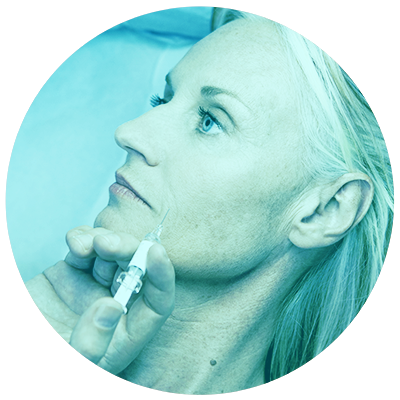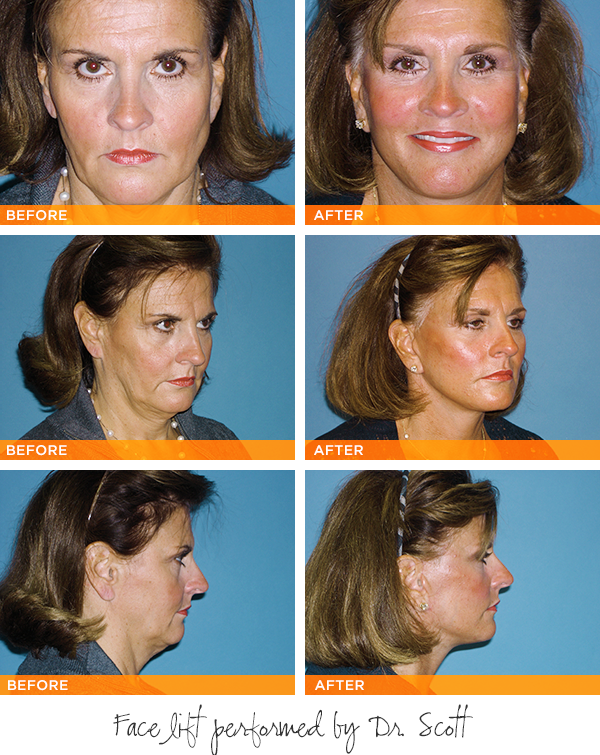“A well-done facial rejuvenation makes patients look as they did when they were younger, but does not change their unique appearance.”
Board-certified plastic surgeon, Dr. Jeff Scott, recently sat down with us to answer questions about his different approaches to facial rejuvenation at The Plastic Surgery Center in Sarasota, Florida.
When a patient is looking for facial rejuvenation, how do you determine the most appropriate procedure?
It is most important to listen to the patient’s individual concerns about his or her face and neck. I then evaluate the patient holistically, considering age, medical conditions, medications, previous facial surgery, weight gain/loss, level of physical activity and smoking history. Next, I perform a thorough evaluation of the forehead, periocular area (around the eyes), mid-face, lower face and neck. Based on this information, I recommend a procedure or combination of procedures that best suits the patient’s desires while creating a harmonious, youthful and natural appearance.
Please tell us about the cases in which you might perform a facelift in conjunction with other facial or neck procedures.
The forehead, eyelids, face and neck are really one aesthetic unit. If a patient has multiple areas that create a more aged appearance, I point out all of the areas and suggest the best combination of procedures. For instance, if a facelift alone is performed on a patient who also has hooding of the upper eyelids and lower lid “bags,” the upper and lower eyelid area could actually appear proportionately worse and more aged after the procedure. In these cases, I might recommend accompanying the facelift with browlift and eyelid surgery.

What does the consultation process for a facelift entail? What are some common goals/concerns/expectations you discuss with patients?
A complete medical history and facial examination is performed. After recommending the appropriate facial rejuvenation procedure or procedures, I explain the entire process. This includes anesthesia, an overview of the surgical procedure(s), the recovery process, the expected outcome, and a discussion of realistic expectations. I also discuss any potential complications or risks.
Common patient goals include lifting the mid-face and cheek fat pads, sharpening up the jawline/jowl area, and tightening neck skin laxity. Patients also often desire to reduce “skin hooding” and the “puffy” lower lid fat pockets around the eye. My goal is to make patients appear more youthful and rested. A well-done facial rejuvenation makes patients look as they did when they were younger, but does not change their unique appearance.
Do you find there is a specific age when patients considering facial rejuvenation typically change from thinking about it non-surgically to surgically?
Every individual differs in his or her facial aging process. As a result, the age at which most people begin to consider surgical facial rejuvenation varies widely. Patients typically begin to consider surgical facial rejuvenation anywhere from their mid 40’s to their early 50’s.

Please tell us how injectable fillers can be used to complement results from facelift surgery.
Injectable fillers are most often used to soften the appearance of early aging in patients who are not yet in need of a facelift-type procedure. Common areas for this application include the nasolabial folds and the “frown line” creases extending below the corner of the lips. Injectable fillers also can be applied to complement the results of a facelift procedure. The aging process creates laxity and a gravity-induced descent of the facial skin and its underlying fat pockets. A lesser-known aspect of the aging process is the loss of volume in the upper face/cheekbone area. Injectable fillers are commonly employed in conjunction with facelift procedures to provide volume and give the face an overall more youthful appearance.

What injectable fillers do you use, and why do you use these particular products? Do you also employ fat grafting techniques? If so, please elaborate.
I offer a number of synthetic injectable fillers, but most commonly use hyaluronic acid products such as JUVÉDERM® XC and JUVÉDERM VOLUMA™ XC. I also perform autologous fat grafting to the face, breast, and gluteal area. I typically use JUVÉDERM® in areas around the mouth because it is very smooth and does not produce lumps. The results from this product tend to last from 9 to 12 months. JUVÉDERM® is excellent for treating nasolabial folds, marionette frown lines, lip lines and lip enhancement. JUVÉDERM VOLUMA™ gained FDA Approval in December of 2013 for use in the upper midface/cheekbone area. The longevity of JUVÉDERM VOLUMA™ is approximately two years.
In certain parts of the face, including the periorbital, lower lid and tear trough areas, I utilize fat grafting rather than hyaluronic acid products. I most commonly utilize fat grafting in patients undergoing a facelift who would also benefit from volume in the cheekbone, eyelid/cheek junction and the midface. Fat grafting has the benefit of providing more permanent volume. A disadvantage of the technique is the acute reabsorption of some of the fat transferred. I generally expect only 50 to 70 percent of the fat grafts to survive permanently.
How long does it take to recover from a facelift procedure?
The recovery from facelift procedures is relatively easy, with very little discomfort for the most part. Patients need to remain somewhat inactive for 2 to 3 days to minimize the potential for bleeding. There always is some swelling and bruising that usually resolve within 10 to 14 days.

What are the most important pre and post-surgery concerns?
The most important considerations prior to a facelift procedure are the patient’s overall health condition, and his or her expectations for the outcome. Patients must have a realistic understanding of the results they will see from a facelift. It’s also important that the patient is well informed about all aspects of the procedure, potential side effects, complications and postoperative recovery. Blood thinners, including non-steroidal anti-inflammatory drugs, should be discontinued two weeks prior to surgery. Smoking should be discontinued at least three weeks prior to surgery due to the detrimental effect it has on wound healing.
Contact Our Office
To learn more about facial rejuvenation, or to schedule a consultation with Dr. Scott,
please don’t hesitate to contact our office today.
![]()



0 Responses to “Demystifying Facial Rejuvenation”
ShoibMyint says:
Facial rejuvenation and body contouring are becoming several of the in demand, current operations for aesthetic surgery. Both are broad terms that can encompass a large range of procedures. Each cosmetic surgery option has the power to transform a person, taking years from their image. Many surgeons are presently offering these new cosmetic options.